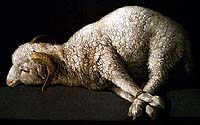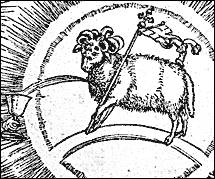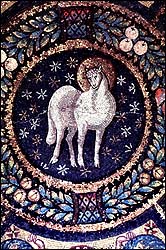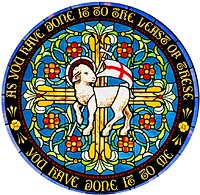Responsorial Psalm: 40:2, 4, 7-8, 8-9, 10
Reading II: 1 Corinthians 1:1-3
Gospel: John 1:29-34
From an early Church Father, Cyril of Alexandria:
When he saw Jesus coming toward him John said: “Behold the Lamb of God, who takes away the sin of the world.”
No longer does he say: Prepare. That would be out of place now that at last he who was prepared for is seen, is before our very eyes. The nature of the case now calls for a different type of homily. An explanation is needed of who is present, and why he has come down to us from heaven.
So John says: Behold the Lamb of God, of whom the prophet Isaiah told us in the words: He was led like a sheep to the slaughter, and like a lamb before his shearer he opened not his mouth.
You can read the rest of Cyril of Alexandria's homily here.
Focusing on the Gospel:
Key words and phrases: John . . . saw Jesus, baptizing with water, one who sent me, see the Spirit come down and remain, Behold the Lamb of God
To the point: John was actively watching for the Messiah. Faithful to his mission to baptize all those who came to him, John readily recognized Jesus as the Messiah when the Spirit came down and rested upon him.
~~~~~~~~~~~~~~~~~~~~~~~~~~~~~~~~~~~~~~~~~~~~~~~~~~~~~~~~~~~~~~~~~~~~~~~~~~
Key words and phrases: John . . . saw Jesus, baptizing with water, one who sent me, see the Spirit come down and remain, Behold the Lamb of God
To the point: John was actively watching for the Messiah. Faithful to his mission to baptize all those who came to him, John readily recognized Jesus as the Messiah when the Spirit came down and rested upon him.
What about us: We too recognize Jesus when we actively watch for his coming into our lives and must remain faithful to the mission God has given us.
Our mission: There is a clear mission we all have - Matthew 22: 36-40
- To love and serve the Lord your God with all your heart, with all your soul, and with all your mind.
- And to love your neighbor as yourself.
- The whole law and the prophets depend on these two commandments.
How we live out that mission brings us closer or farther from God. We need to always remember to ask God to show us the vocation He has chosen for us. I believe that should be a foundational prayer.
"God please make known to me my vocation. Grant me the wisdom to know what you want me to do. Please help me trust in You. Please give me the courage and passion to live the life you want me to live. I believe, Lord! Help my disbelief! Not my will but yours be done! And, Lord, if it is not too much to ask . . . please bend me to your will so that I may better serve you. Through Jesus Christ Our Lord. Amen."
Connecting the Gospel:
to the first reading: Israel, God’s servant, shines with the glory of God and leads all nations to salvation.
to the first reading: Israel, God’s servant, shines with the glory of God and leads all nations to salvation.
In the gospel Jesus is the glorified One upon whom the Spirit rests and who leads all nations to salvation.
to experience: We see what we look for. If we look for Jesus, we will see him
~~~~~~~~~~~~~~~~~~~~~~~~~~~~~~~~~~~~~~~~~~~~~~~~~~~~~~~~~~~~~~~~~~~~~~~~~~
Scott Hahn's Reflection on the Readings!
Perfect Offering Listen Here!
Jesus speaks through the prophet Isaiah in today’s First Reading.
He tells us of the mission given to Him by the Father from the womb: “‘You are My servant,’ He said to Me.”
Servant and Son, our Lord was sent to lead a new exodus - to raise up the exiled tribes of Israel, to gather and restore them to God. More than that, He was to be a light to the nations, that God’s salvation may reach to the ends of the earth (see Acts 13:46-47).
Before the first exodus, a lamb was offered in sacrifice and its blood painted on the Israelites’ door posts. The blood of the lamb identified their homes and the Lord “passed over” these in executing judgment on the Egyptians (see Exodus 12:1-23,27).
In the new exodus, Jesus is the “Lamb of God,” as John beholds Him in the Gospel today (see 1 Corinthians 5:7; 1 Peter 1:18-19). Our Lord sings of this in today’s Psalm. He has come, He says, to offer His body to do the will of God (see Hebrews 10:3-13).
The sacrifices, oblations, holocausts, and sin-offerings given after the first exodus had no power to take away sins (see Hebrews 10:4). They were meant not to save but to teach (see Galatians 3:24). In offering these sacrifices, the people were to learn self-sacrifice - that they were made for worship, to offer themselves freely to God and to delight in His will.
Only Jesus could make that perfect offering of himself. And through His sacrifice, He has given us ears open to obedience, made it possible for us to hear the Father’s call to holiness, as Paul says in today’s Epistle.
He has made us children of God, baptized in the blood of the Lamb (see Revelation 7:14). And we are to join our sacrifice to His, to offer our bodies - our lives - as living sacrifices in the spiritual worship of the Mass (see Romans 12:1).

Yours in Christ,

Scott Hahn, Ph.D.
~~~~~~~~~~~~~~~~~~~~~~~~~~~~~~~~~~~~~~~~~~~~~~~~~~~~~~~~~~~~~~~~~~~~~~~~~~
Scott Hahn's Reflection on the Readings!
January 16, 2011 - 2nd Sunday in Ordinary Time
Perfect Offering Listen Here!
Jesus speaks through the prophet Isaiah in today’s First Reading.
He tells us of the mission given to Him by the Father from the womb: “‘You are My servant,’ He said to Me.”
Servant and Son, our Lord was sent to lead a new exodus - to raise up the exiled tribes of Israel, to gather and restore them to God. More than that, He was to be a light to the nations, that God’s salvation may reach to the ends of the earth (see Acts 13:46-47).
Before the first exodus, a lamb was offered in sacrifice and its blood painted on the Israelites’ door posts. The blood of the lamb identified their homes and the Lord “passed over” these in executing judgment on the Egyptians (see Exodus 12:1-23,27).
In the new exodus, Jesus is the “Lamb of God,” as John beholds Him in the Gospel today (see 1 Corinthians 5:7; 1 Peter 1:18-19). Our Lord sings of this in today’s Psalm. He has come, He says, to offer His body to do the will of God (see Hebrews 10:3-13).
The sacrifices, oblations, holocausts, and sin-offerings given after the first exodus had no power to take away sins (see Hebrews 10:4). They were meant not to save but to teach (see Galatians 3:24). In offering these sacrifices, the people were to learn self-sacrifice - that they were made for worship, to offer themselves freely to God and to delight in His will.
Only Jesus could make that perfect offering of himself. And through His sacrifice, He has given us ears open to obedience, made it possible for us to hear the Father’s call to holiness, as Paul says in today’s Epistle.
He has made us children of God, baptized in the blood of the Lamb (see Revelation 7:14). And we are to join our sacrifice to His, to offer our bodies - our lives - as living sacrifices in the spiritual worship of the Mass (see Romans 12:1).
Yours in Christ,

Scott Hahn, Ph.D.
~~~~~~~~~~~~~~~~~~~~~~~~~~~~~~~~~~~~~~~~~~~~~~~~~~~~~~~~~~~~~~~~~~~~~~~~~~
SOURCES:
- Cyril of Alexandria *
- Thoughts from the Early Church @Center for Sunday Liturgy
- Living Liturgy: Spirituality, Celebration, and Catechesis for Sundays and Solemnities Year A - 2011, p. 45. Joyce Ann Zimmerman, CPPS; Kathleen Harmon, SND de N; and Christopher W. Conlon, SM
* Cyril of Alexandria (d.444) succeeded his uncle Theophilus as patriarch in 412. Until 428 the pen of this brilliant theologian was employed in exegesis and polemics against the Arians; after that date it was devoted almost entirely to refuting the Nestorian heresy. The teaching of Nestorius was condemned in 431 by the Council of Ephesus at which Cyril presided, and Mary’s title, Mother of God, was solemnly recognized.
The incarnation is central to Cyril’s theology. Only if Christ is consubstantial with the Father and with us can he save us, for the meeting ground between God and ourselves is the flesh of Christ. Through our kinship with Christ, the Word made flesh, we become children of God, and share in the filial relation of the Son with the Father.
The incarnation is central to Cyril’s theology. Only if Christ is consubstantial with the Father and with us can he save us, for the meeting ground between God and ourselves is the flesh of Christ. Through our kinship with Christ, the Word made flesh, we become children of God, and share in the filial relation of the Son with the Father.
LAGNIAPPE: Paintings of Lamb of God - Agnus Dei
Drawing for the Agnus Dei, Giulio Romano, ink on paper c.1540Adoration of the Lamb, by Jan van Eyck (1432), oil on wood, Ghent altarpiece, Cathedral of St. Bavo, Ghent.
Paul Myhill, Agnus Dei (contemporary painter)
The Lamb of God in the heaven.ceiling of the vatican embassy in Sofia, Bulgaria
Izumi Fukushima, Japanese-style painting artist, Romanesque Lamb of God. Contemporary painter.
Niko Pirosmani, God's Lamb, Oil on oil-cloth, 55x61 cm. The State Museum of Fine Arts of Georgia, Tbilisi.
Painting of the Agnus Dei (Lamb of God) above the apse windows by Joseph Reiter. St. Vincent Bascilica Parish, Latrobe, PA. (Virtual Tour of St. Vincent Bascilica in PA)
Saint Patrick's Cathedral, Ireland, Saint Peter's Chapel, the Jellett window with Lamb of God, created by C.E. Kemp. San Vitale, Ravenna (begun 532, consecrated 547A.D),
Francisco de Zurbaran, (Spanish painter, 1598-1664) Agnus Dei (1635-40), bound lamb with horns. Canvas 38 x 62 cm. Museo Nacional del Prado, Madrid.
Saint Patrick's Cathedral, Ireland, Saint Peter's Chapel, the Jellett window with Lamb of God, created by C.E. Kemp. San Vitale, Ravenna (begun 532, consecrated 547A.D),
Francisco de Zurbaran, (Spanish painter, 1598-1664) Agnus Dei (1635-40), bound lamb with horns. Canvas 38 x 62 cm. Museo Nacional del Prado, Madrid.
 |
| Francisco de Zurbaran (1598-1664), "Agnus Dei" (1635-40) ,Canvas 38 x 62 cm. Museo Nacional del Prado, Madrid. Larger image. |
Woodcuts
 Detail of "Adoration of the Lamb" (1496-98) woodcut by Albrecht Durer. Larger image. |
Albrecht Durer (German painter, 1471-1528)
Adoration of the Lamb (1496-98), woodcut in Apocalypse of St. John series, each 39 x 28cm, Detail.
Sculpture, Carvings of Lamb of God
- Bronze Agnus Dei sculpture, unknown location.
- El Cordero de Dios (Agnus Dei), symbol over unknown cathedral entrance
- Maulbronn Monastery church Baden-Wuerttemberg, ceiling rib vault bosses (1424), Lamb of God.
Painting of Scene with John the Baptist pointing to Jesus as the Lamb of God
Dieric Bouts d. Ä. (1410 - 1475) (1410 - 1475), "Ecce Agnus Dei", (1462/64)Agnus Dei Stained Glass Windows
-
Dollis Hill, London, Ecce Agnus Dei, by Margaret Edith Rope ("Tor") - Croydon, All Saints, Agnus Dei.
- James Powell & Sons stained glass, Agnus Dei detail, at Holy Trinity church, Lomas de Zamora. They were designed by one of the firm's principal artists, Charles Hardgrave, and date from 1896.
- Memorah and Lamb of God Windows at Immanuel Seymor
- The Lamb of God window, beside the Sacred Heart Altar, Our Lady of Mount Carmel, Munich Studios stained glass, Wyandotte, Michigan
- Curtis Graphics, Lamb of God window
Mosaic Tile
- Floor of Nativity of Mary Blessed Virgin Catholic Chruch, Schulenburg, Texas, Lamb of God. A Painted Church of Texas!
Miscellaneous
- Tile Agnus Dei, at St. Mary's Episcopal Cathedral, Edinburgh.
- Reliquary Casket with the Lamb of God and a Personification of the Church, French (Limoges)
About 1185-95, enamel on copper, Private collection
Collections
- Mnemosyne MIA : ICONCLASS 11D1311 lamb bearing cross or banner, 'Agnus Dei' ~ symbol of Christ. Shows manuscript examples. Java script - slow moving but an interesting site
~~~~~~~~~~~~~~~~~~~~~~~~~~~~~~~~~~~~~~~~~~~~~~~~~~~~~~~~~~~~~~~~~~~~~~~~~~
SOURCES:
Cyril of Alexandria * Thoughts from the Early Church @Center for Sunday Liturgy
Living Liturgy: Spirituality, Celebration, and Catechesis for Sundays and Solemnities Year A - 2011, p. 45. Joyce Ann Zimmerman, CPPS; Kathleen Harmon, SND de N; and Christopher W. Conlon, SM
* Cyril of Alexandria (d.444) succeeded his uncle Theophilus as patriarch in 412. Until 428 the pen of this brilliant theologian was employed in exegesis and polemics against the Arians; after that date it was devoted almost entirely to refuting the Nestorian heresy. The teaching of Nestorius was condemned in 431 by the Council of Ephesus at which Cyril presided, and Mary’s title, Mother of God, was solemnly recognized.
The incarnation is central to Cyril’s theology. Only if Christ is consubstantial with the Father and with us can he save us, for the meeting ground between God and ourselves is the flesh of Christ. Through our kinship with Christ, the Word made flesh, we become children of God, and share in the filial relation of the Son with the Father.
~~~~~~~~~~~~~~~~~~~~~~~~~~~~~~~~~~~~~~~~~~~~~~~~~~~~~~~~~~~~~~~~~~~~~~~~~~






No comments:
Post a Comment